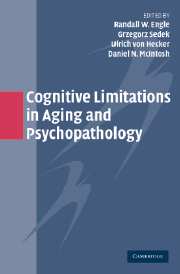Book contents
- Frontmatter
- Contents
- List of Contributors
- Preface
- Acknowledgments
- 1 Cognitive Limitations in Aging and Psychopathology: An Introduction and a Brief Tutorial to Research Methods
- SECTION I WORKING MEMORY AND COGNITIVE FUNCTIONS
- 2 Working Memory Capacity in Hot and Cold Cognition
- 3 Age Differences and Individual Differences in Cognitive Functions
- 4 Stress and Working Memory: Between-Person and Within-Person Relationships
- SECTION II AGING AND PSYCHOPATHOLOGY OF COGNITIVE CONTROL
- SECTION III ATTENTION, INHIBITION, AND REASONING PROCESSES
- Name Index
- Subject Index
- References
2 - Working Memory Capacity in Hot and Cold Cognition
Published online by Cambridge University Press: 20 May 2010
- Frontmatter
- Contents
- List of Contributors
- Preface
- Acknowledgments
- 1 Cognitive Limitations in Aging and Psychopathology: An Introduction and a Brief Tutorial to Research Methods
- SECTION I WORKING MEMORY AND COGNITIVE FUNCTIONS
- 2 Working Memory Capacity in Hot and Cold Cognition
- 3 Age Differences and Individual Differences in Cognitive Functions
- 4 Stress and Working Memory: Between-Person and Within-Person Relationships
- SECTION II AGING AND PSYCHOPATHOLOGY OF COGNITIVE CONTROL
- SECTION III ATTENTION, INHIBITION, AND REASONING PROCESSES
- Name Index
- Subject Index
- References
Summary
Much has been said about the relationship between measures of Working Memory Capacity (WMC) and higher order cognition. Indeed, what exactly accounts for this relationship has been a major topic of inquiry in cognitive psychology for over 20 years (Engle & Oransky, 1999). Attempts to better understand this problem have shed considerable light on the role of WMC in a wide array of research domains. Specifically, research has shown that measures of WMC are related to complex learning (Kyllonen & Stephens, 1990), following directions (Engle, Carullo, & Collins, 1991), reasoning ability (Engle, Tuholski, Laughlin, & Conway, 1999; Kyllonen & Christal, 1990), and vocabulary learning (Daneman & Green, 1986). Additionally, not only has WMC been implicated in higher order cognition – indeed, these correlations point to the utility of such a concept in the first place – but also now WMC is being implicated in other research domains. Working memory measures not only predict reading comprehension scores (Daneman & Carpenter, 1980), performance on standard achievement tests (i.e., SAT: Engle et al., 1999), and reasoning, but also seem to predict early onset Alzheimer's (Rosen, Bergeson, Putnam, Harwell, & Sunderland, 2002), the effects of alcohol consumption (Finn, 2002), and one's ability to deal with life-event stress (Klein & Boals, 2001). Thus, the utility of WMC is not merely limited to performance on high-level cognitive tasks, but is also important in a variety of situations that impact people on a day-to-day basis.
- Type
- Chapter
- Information
- Cognitive Limitations in Aging and Psychopathology , pp. 19 - 43Publisher: Cambridge University PressPrint publication year: 2005
References
- 19
- Cited by

